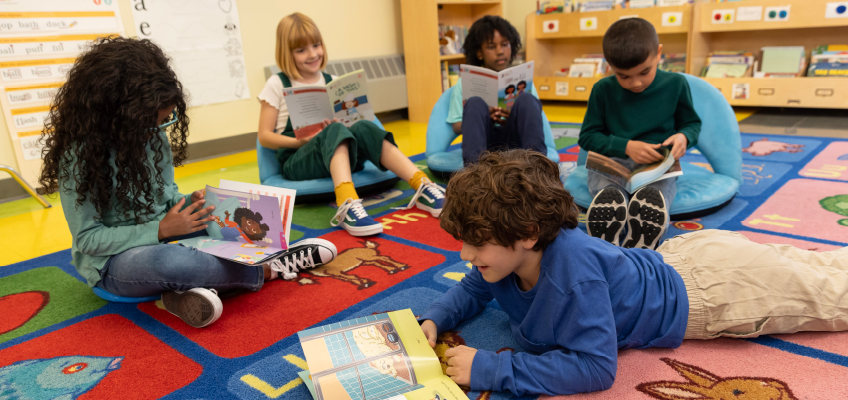
Learning to read is a journey, and as teachers, selecting the right texts can make all the difference. To build strong, confident readers, it’s important to introduce them to different types of texts that align with their growing skills. Decodable, bridge, and authentic texts each play a crucial role in this process, supporting students at various points along the way. Let’s take a closer look at each one while describing their importance and how they can be used effectively in the classroom.
Decodable texts are a vital starting point for emergent and early readers, helping them practice and apply taught phonics skills in a meaningful way through reading connected text. These texts are carefully designed and comprised primarily of words that follow the phonetic patterns and spelling rules students have already been taught. While the optimal percentage of pre-taught words or skills is unclear (Cheatham & Allor, 2012; Mesmer, 2001; Pugh et al., 2023), it is sensible to consider that higher percentages provide more practice opportunities. A text with 95% or more decodability that aligns with a program’s scope and sequence allows students to have repeated practice reading words in connected text. Text with a high percentage of words containing taught phonics elements and high-frequency words ensures that students have sufficient practice to decode them with confidence. By reading these texts, students strengthen their decoding skills and build word recognition, key components of reading fluency.
Fundations® Reader are a great example of decodable texts. Aligned with Fundations, a program that follows a Structured Literacy approach to instruction, these texts gradually introduce new phonics elements while reinforcing previously taught concepts. As students read, they are applying knowledge of the phonics patterns they’ve learned in a controlled, cumulative way. This steady progression helps them develop automaticity in reading, making it easier to transition to more complex texts as their skills grow.
The importance of decodable texts lies in their ability to connect foundational skills development to real reading experiences. They provide students with the chance to practice decoding words in context, strengthening their ability to read connected text with accuracy and fluency. Decodable texts also support comprehension by reducing cognitive load—students don’t need to struggle with unfamiliar words, allowing them to focus on understanding the vocabulary and the text’s meaning.
As students become more proficient with decoding, bridge texts offer a natural next step. These texts are slightly more complex than decodable texts, typically with decodability between 80% and 85%, but still aligned to taught phonic elements and high-frequency words. They help students transition from controlled practice to reading less controlled texts by introducing new vocabulary and slightly more challenging sentence structures. This increase in complexity helps students apply their phonics skills in a more authentic reading context (Cavanaugh & Sheaffer, 2024).
Bridge texts are ideal for reinforcing both decoding and comprehension skills. For example, Geodes® are a popular choice that follow the Fundations Scope and Sequence, providing thematically rich connected text practice that is at least 80 percent decodable. Reading text sets on a specific topic, like oceans or honeybees, helps build background knowledge and vocabulary development, giving students repeated interactions with words containing phonic elements that have not yet been directly taught, but have become familiar through content, instruction, and multiple exposures.
The significance of bridge texts is clear: they offer the perfect balance between familiar and new. By combining both known and unfamiliar elements, they challenge students just enough to promote growth without overwhelming them. As students read bridge texts, they continue to refine their decoding skills while also gaining confidence in reading more complex material. This process helps build fluent reading and prepares students for the ultimate goal: reading and comprehending authentic texts.
Authentic texts are real-world materials such as stories, biographies, informational text, or poems. It’s important to select authentic texts that are rich in vocabulary, complex sentence structures, and diverse themes to encourage critical thinking and deeper comprehension. While the goal is for students to independently read authentic grade-level texts, these texts also can provide valuable opportunities for students to engage with content that extends beyond their current reading abilities and builds knowledge beyond what they gain through real-life experience.
Reading authentic texts is an essential part of developing advanced reading skills. They expose students to new ideas, writing styles, and language patterns, helping them grow as readers. A teacher’s daily practice of orally reading high-quality texts that are one or two grade levels above students’ reading levels can further support this growth. By listening to these texts, students are exposed to more sophisticated language, which in turn improves their vocabulary and comprehension skills.
The aim of authentic texts is to foster fluency, comprehension, and a love of reading. As students tackle more complex texts, they apply all the foundational skills they’ve built with decodable and bridge texts. This not only helps them read more easily but also strengthens their ability to think critically about what they read. The ultimate reward is a lifelong passion for reading, as students discover the joy and value of engaging with diverse, thought-provoking material.
As students work with these text types concurrently through the selection of appropriate reading tasks, they are not only building their reading skills but also gaining the tools they need to succeed in the world of written language. With the right support and resources, every reader can go from decoding words to reading with fluency and understanding, ready to explore the world through the power of books.